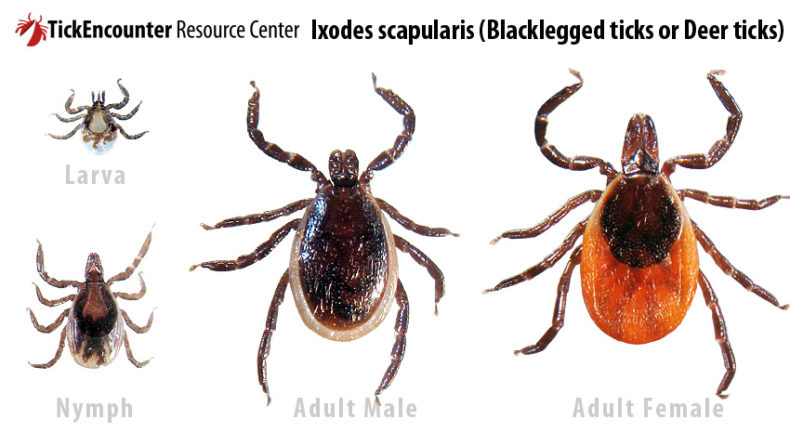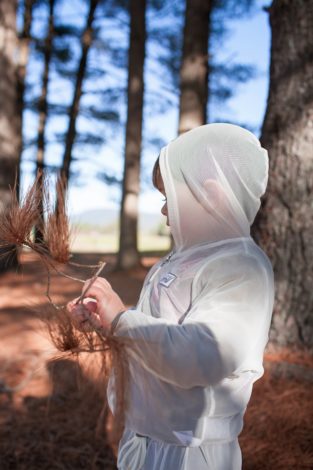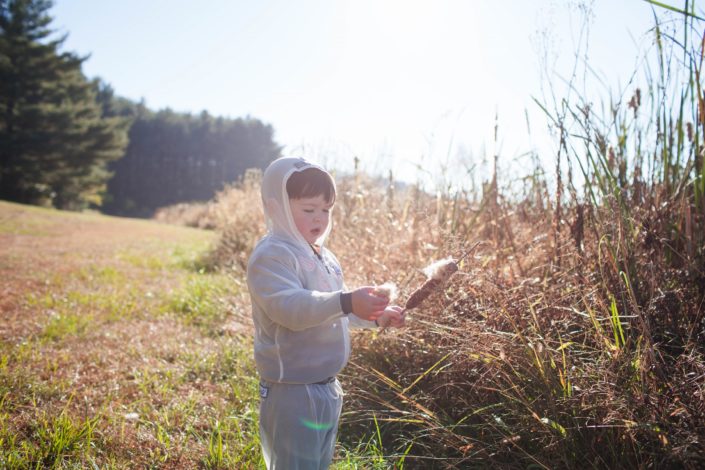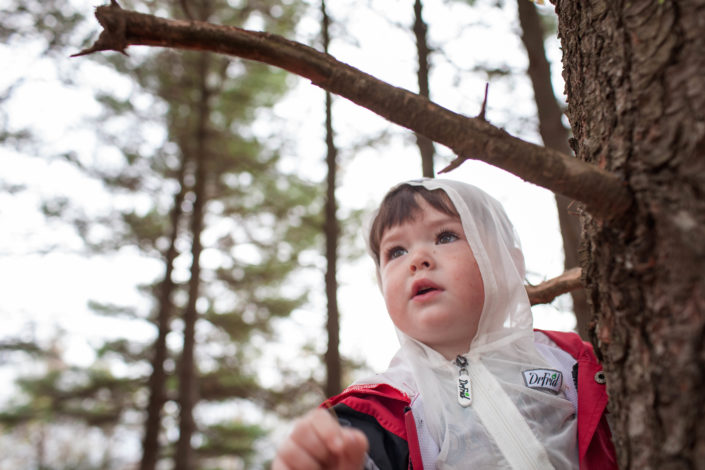Tick Prevention in Colder Months
- Blog Tick Prevention in Colder Months
“Tick season is finally over, right?” Well … not quite. Technically, every season is “tick season.” Contrary to popular belief, ticks don't just disappear in the colder months. Some tick species are simply less active. Take year-round precautions to prevent tick bites and the diseases that can come with them.
Ticks in the Winter?!
Yes, unfortunately. According to the TickEncounter Resource Center, some tick species (such as the Lone Star and American Dog ticks) are not active in the fall and winter months. But other tick species can remain active from the fall to the spring if the air temperature is above freezing. The Blacklegged (deer) tick is the most common cold-weather tick and a known carrier of disease-causing agents, such as Lyme bacteria. Around 50% of adult deer ticks carry the Lyme bacteria.
As a reminder, ticks cannot jump, run or fly. Instead, they wait patiently in grass, leaves, trees and vegetation for a host to brush up close enough for it to attach itself. From there, they then crawl to a desired point on your body. If you find a tick on your head, it crawled there from a lower point on your body.
Curious about tick activity in your area? You can find out if your area is at risk for ticks and which ticks to look out for.
 DrFrid Kidswear provides head-to-toe protection.
While the thought of a tick bite can be scary, don't let that fear keep you inside! The CDC has compiled a list of helpful steps to prevent tick bites while enjoying nature safely. Their number one tip is to walk in the center of the trail and avoid areas with leaf litter and tall grass. Here at Hike it Baby, we know that this isn’t always the easiest task when you have a toddler running around exploring the exciting world of the outdoors! These remaining steps can help to ease your mind so that you can enjoy your time outdoors.
DrFrid Kidswear provides head-to-toe protection.
While the thought of a tick bite can be scary, don't let that fear keep you inside! The CDC has compiled a list of helpful steps to prevent tick bites while enjoying nature safely. Their number one tip is to walk in the center of the trail and avoid areas with leaf litter and tall grass. Here at Hike it Baby, we know that this isn’t always the easiest task when you have a toddler running around exploring the exciting world of the outdoors! These remaining steps can help to ease your mind so that you can enjoy your time outdoors.
 Playtime has no boundaries as DrFrid Kidswear's innovative Insect Shield repels bugs and mosquitos, including those that can carry diseases.
While all of the above recommendations are helpful ways to deter ticks, the easiest and most effective way to repel ticks, mosquitos, fleas, etc., is with DrFrid Kidswear. As a method for protecting young hikers, while also putting their parents' fears at ease, DrFrid discovered Kidswear, an innovative new active wear that utilizes Insect Shield repellent technology used by the U.S. military to treat clothing with permethrin in the protection against ticks and unwanted bugs and is supported by the CDC. The apparel repels insects, including those that can carry Lyme disease, West Nile virus, malaria and other insect-borne diseases.
The Kidswear set contains a jacket with a hood, sleeve guards and pants that are breathable, ultralight and odorless. They come in sizes 2-14 and are perfect year-round and lasts 25 washes. They can be worn over or under clothing for all activities, such as hiking, camping or everyday play at the park or your own backyard.
Playtime has no boundaries as DrFrid Kidswear's innovative Insect Shield repels bugs and mosquitos, including those that can carry diseases.
While all of the above recommendations are helpful ways to deter ticks, the easiest and most effective way to repel ticks, mosquitos, fleas, etc., is with DrFrid Kidswear. As a method for protecting young hikers, while also putting their parents' fears at ease, DrFrid discovered Kidswear, an innovative new active wear that utilizes Insect Shield repellent technology used by the U.S. military to treat clothing with permethrin in the protection against ticks and unwanted bugs and is supported by the CDC. The apparel repels insects, including those that can carry Lyme disease, West Nile virus, malaria and other insect-borne diseases.
The Kidswear set contains a jacket with a hood, sleeve guards and pants that are breathable, ultralight and odorless. They come in sizes 2-14 and are perfect year-round and lasts 25 washes. They can be worn over or under clothing for all activities, such as hiking, camping or everyday play at the park or your own backyard.
 DrFrid Kidswear is breathable and comfortable, and can be worn over or under clothes.
In addition, kids tend to find it more convenient than wearing bug sprays. Little ones are free to comfortably roam about the outdoors. Also, no more of those repellent sprays that can be difficult to apply and reapply. Not to mention sprays are often sticky, smelly and can cause skin irritation.
[embed]https://youtu.be/vQ1Kshve6ec[/embed]
Even though ticks can stay active all year-round, fear of them shouldn’t keep us from enjoying the amazing, gorgeous world of nature! Following the recommendations in this article (especially using tick repellent clothing and carrying a tick kit) can help put our minds at ease so we can enjoy watching our children discover the miraculous world right outside our front door.
DrFrid Kidswear is breathable and comfortable, and can be worn over or under clothes.
In addition, kids tend to find it more convenient than wearing bug sprays. Little ones are free to comfortably roam about the outdoors. Also, no more of those repellent sprays that can be difficult to apply and reapply. Not to mention sprays are often sticky, smelly and can cause skin irritation.
[embed]https://youtu.be/vQ1Kshve6ec[/embed]
Even though ticks can stay active all year-round, fear of them shouldn’t keep us from enjoying the amazing, gorgeous world of nature! Following the recommendations in this article (especially using tick repellent clothing and carrying a tick kit) can help put our minds at ease so we can enjoy watching our children discover the miraculous world right outside our front door.

Image from TickEncounter Resource Center http://www.tickencounter.org/tick_identification/deer_tick
Are Tick Bites Really that Bad?
They certainly can be! According to the Centers for Disease Control and Prevention (CDC), tick-borne diseases are on the rise, and their range is spreading. Ticks have been reported in all 50 states and don't just carry Lyme disease but also other non-treatable and deadly diseases, such as Pawasen and Bornon viruses, that are on the rise. Furthermore, exposure to tick saliva can result in allergies for some people. The most common tick-borne disease is Lyme disease, which can cause various symptoms ranging from fever and headaches to nerve damage and arthritis. Ticks that carry Lyme disease (such as the Blacklegged tick) are most prevalent in the Northeast, upper-Midwest and mid-Atlantic regions of the country. Steps to Protect Against Ticks DrFrid Kidswear provides head-to-toe protection.
While the thought of a tick bite can be scary, don't let that fear keep you inside! The CDC has compiled a list of helpful steps to prevent tick bites while enjoying nature safely. Their number one tip is to walk in the center of the trail and avoid areas with leaf litter and tall grass. Here at Hike it Baby, we know that this isn’t always the easiest task when you have a toddler running around exploring the exciting world of the outdoors! These remaining steps can help to ease your mind so that you can enjoy your time outdoors.
DrFrid Kidswear provides head-to-toe protection.
While the thought of a tick bite can be scary, don't let that fear keep you inside! The CDC has compiled a list of helpful steps to prevent tick bites while enjoying nature safely. Their number one tip is to walk in the center of the trail and avoid areas with leaf litter and tall grass. Here at Hike it Baby, we know that this isn’t always the easiest task when you have a toddler running around exploring the exciting world of the outdoors! These remaining steps can help to ease your mind so that you can enjoy your time outdoors.
- Wear long pants tucked into long socks, long-sleeved shirts tucked into your pants and a hat. In addition, it is highly recommended that you wear clothing treated with a safe repellent like permethrin, which is approved by the CDC. We recommend using pretreated clothing like DrFrid Kidswear for kids or ExOfficio Bugsaway for adults. Pretreated clothing typically lasts longer than using the spray bottles as well so they are worth the little bit extra.
- Use insect repellents that contain 20% to 30% DEET or picaridin on any exposed skin. However, according to the CDC, it is not recommended for use on children under two months. Remember to check your manufacturer instructions on how often to re-apply.
- Don’t forget about furry babies! The use of tick collars, shampoos, sprays, etc., can be effective ways of tick prevention. Also, perform tick checks on your pets frequently. Pay special attention to their ears, armpits, between the toes and around the tail and head.
DrFrid Kidswear: The All-in-One Protection Against Ticks
 Playtime has no boundaries as DrFrid Kidswear's innovative Insect Shield repels bugs and mosquitos, including those that can carry diseases.
While all of the above recommendations are helpful ways to deter ticks, the easiest and most effective way to repel ticks, mosquitos, fleas, etc., is with DrFrid Kidswear. As a method for protecting young hikers, while also putting their parents' fears at ease, DrFrid discovered Kidswear, an innovative new active wear that utilizes Insect Shield repellent technology used by the U.S. military to treat clothing with permethrin in the protection against ticks and unwanted bugs and is supported by the CDC. The apparel repels insects, including those that can carry Lyme disease, West Nile virus, malaria and other insect-borne diseases.
The Kidswear set contains a jacket with a hood, sleeve guards and pants that are breathable, ultralight and odorless. They come in sizes 2-14 and are perfect year-round and lasts 25 washes. They can be worn over or under clothing for all activities, such as hiking, camping or everyday play at the park or your own backyard.
Playtime has no boundaries as DrFrid Kidswear's innovative Insect Shield repels bugs and mosquitos, including those that can carry diseases.
While all of the above recommendations are helpful ways to deter ticks, the easiest and most effective way to repel ticks, mosquitos, fleas, etc., is with DrFrid Kidswear. As a method for protecting young hikers, while also putting their parents' fears at ease, DrFrid discovered Kidswear, an innovative new active wear that utilizes Insect Shield repellent technology used by the U.S. military to treat clothing with permethrin in the protection against ticks and unwanted bugs and is supported by the CDC. The apparel repels insects, including those that can carry Lyme disease, West Nile virus, malaria and other insect-borne diseases.
The Kidswear set contains a jacket with a hood, sleeve guards and pants that are breathable, ultralight and odorless. They come in sizes 2-14 and are perfect year-round and lasts 25 washes. They can be worn over or under clothing for all activities, such as hiking, camping or everyday play at the park or your own backyard.
 DrFrid Kidswear is breathable and comfortable, and can be worn over or under clothes.
In addition, kids tend to find it more convenient than wearing bug sprays. Little ones are free to comfortably roam about the outdoors. Also, no more of those repellent sprays that can be difficult to apply and reapply. Not to mention sprays are often sticky, smelly and can cause skin irritation.
[embed]https://youtu.be/vQ1Kshve6ec[/embed]
Even though ticks can stay active all year-round, fear of them shouldn’t keep us from enjoying the amazing, gorgeous world of nature! Following the recommendations in this article (especially using tick repellent clothing and carrying a tick kit) can help put our minds at ease so we can enjoy watching our children discover the miraculous world right outside our front door.
DrFrid Kidswear is breathable and comfortable, and can be worn over or under clothes.
In addition, kids tend to find it more convenient than wearing bug sprays. Little ones are free to comfortably roam about the outdoors. Also, no more of those repellent sprays that can be difficult to apply and reapply. Not to mention sprays are often sticky, smelly and can cause skin irritation.
[embed]https://youtu.be/vQ1Kshve6ec[/embed]
Even though ticks can stay active all year-round, fear of them shouldn’t keep us from enjoying the amazing, gorgeous world of nature! Following the recommendations in this article (especially using tick repellent clothing and carrying a tick kit) can help put our minds at ease so we can enjoy watching our children discover the miraculous world right outside our front door.
Helpful Online Resources
- DrFrid Kidswear
- Center for Disease Control and Prevention
- TickEncounter Resource Center
- US Environmental Protection Agency
- Project Lyme
Read more:
Photos courtesy of Kendra Reeder. Photo and video courtesy of DrFrid.THIS ARTICLE IS WRITTEN FOR HIKE IT BABY AS AN INFORMATIONAL TOOL FOR READERS. WE ARE NOT EXPERTS IN THIS FIELD AND REFER READERS TO THEIR PERSONAL HEALTHCARE PROVIDERS WHEN SEEKING ADVICE ON MEDICAL MATTERS. REFERENCES TO WELL-RESPECTED WEBSITES AND PROFESSIONALS ARE LINKED IN THIS POST FOR THE MOST UP TO DATE INFORMATION ON THIS TOPIC.
This post is sponsored by DrFrid. Hike it Baby received compensation in exchange for writing this post. All opinions are our own.Related Content




Comments